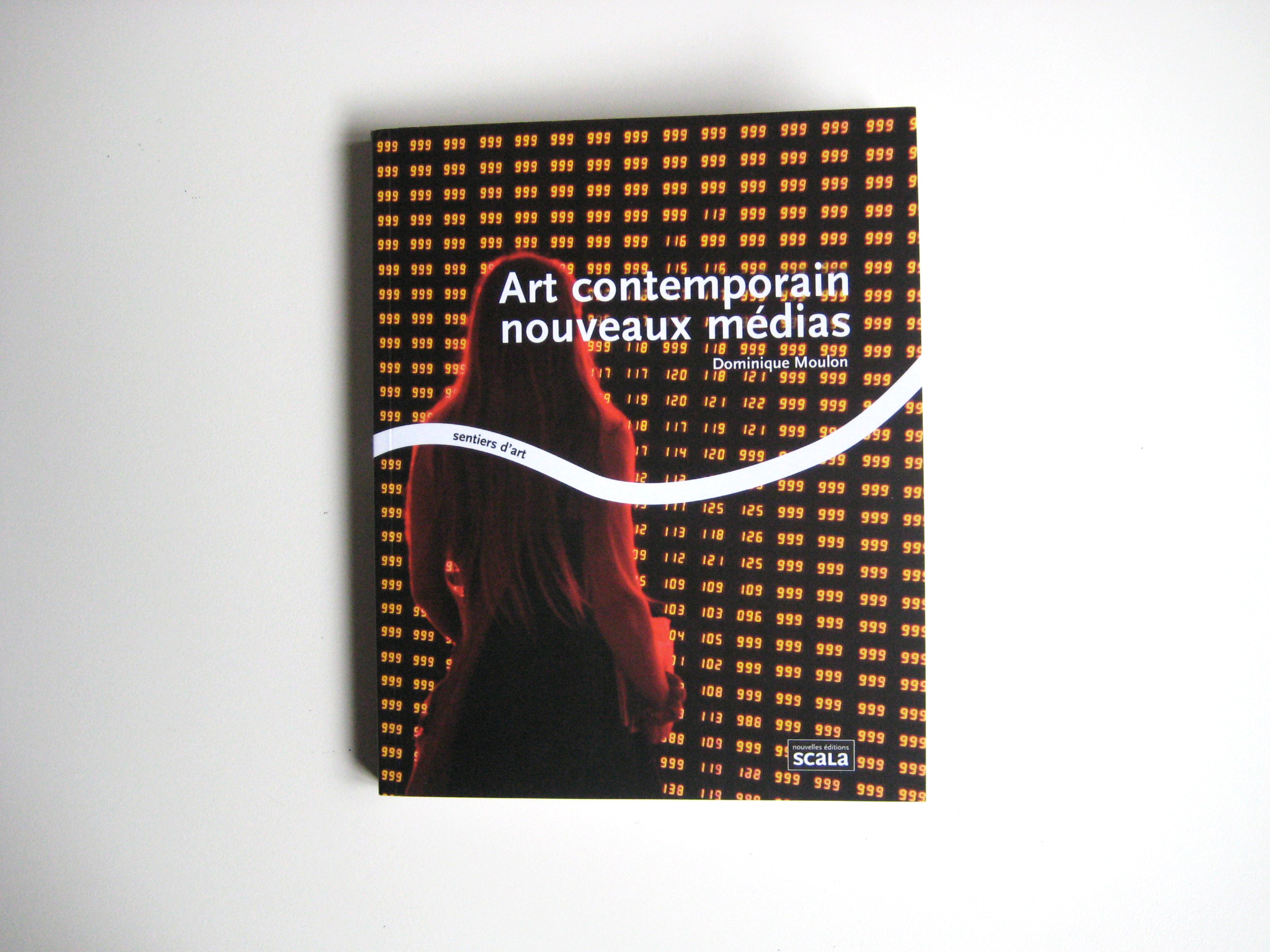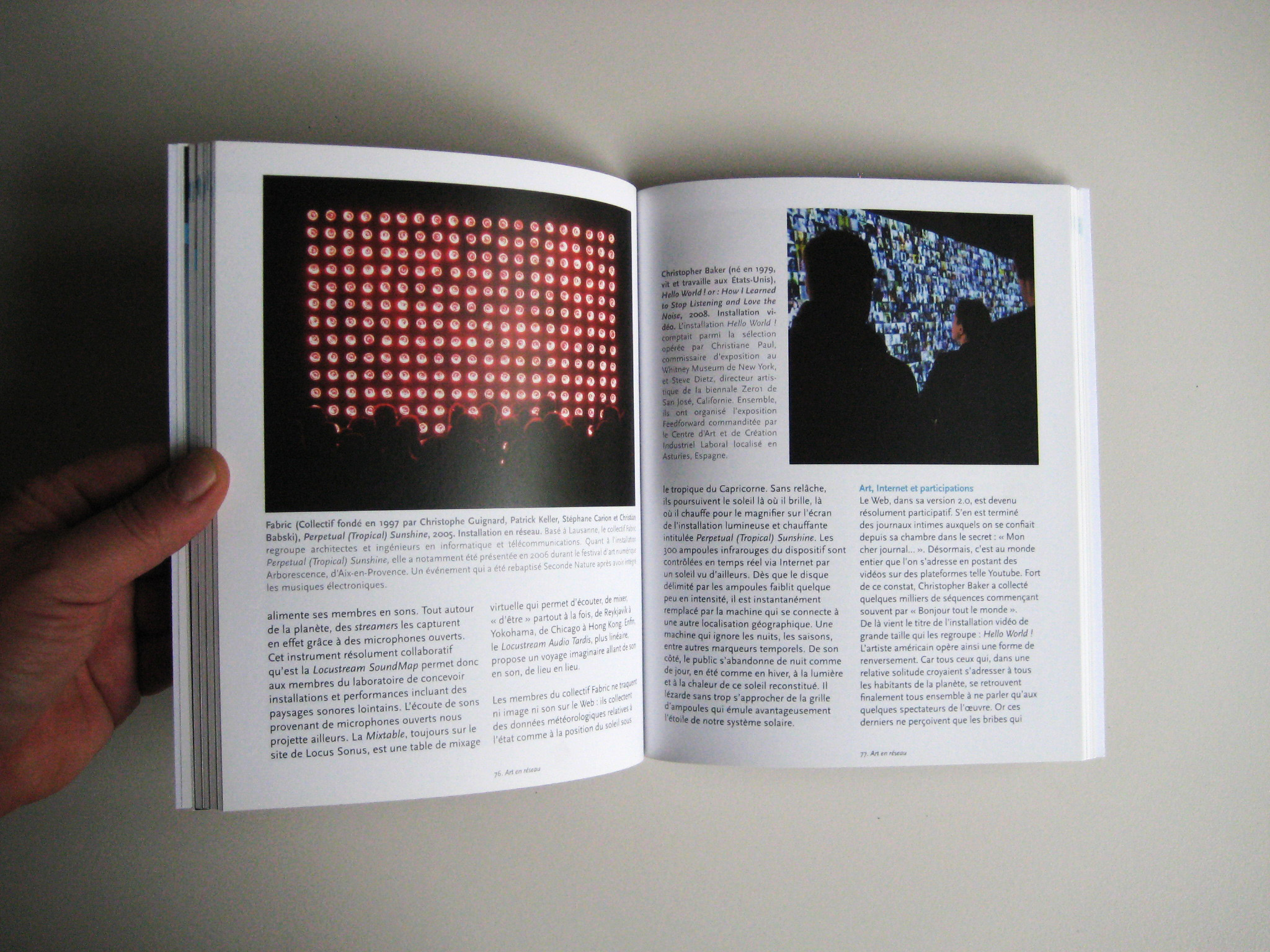Thursday, April 03. 2014
Snowden's mediated mobility | #tele-
Wednesday, February 26. 2014
Picture Piece: Cybersyn, Chile 1971-73 | #cybernetic #history
Three years ago we published a post by Nicolas Nova about Salvator Allende's project Cybersyn. A trial to build a cybernetic society (including feedbacks from the chilean population) back in the early 70ies.
Here is another article and picture piece about this amazing projetc on Frieze. You'll need to buy the magazione to see the pictures, though!
-----
Via Frieze
Phograph of Cybersyn, Salvador Allende's attempt to create a 'socialist internet, decades ahead of its time'
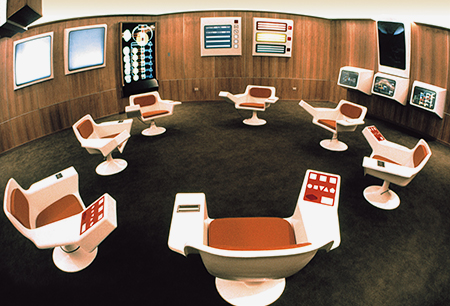
This is a tantalizing glimpse of a world that could have been our world. What we are looking at is the heart of the Cybersyn system, created for Salvador Allende’s socialist Chilean government by the British cybernetician Stafford Beer. Beer’s ambition was to ‘implant an electronic nervous system’ into Chile. With its network of telex machines and other communication devices, Cybersyn was to be – in the words of Andy Beckett, author of Pinochet in Piccadilly (2003) – a ‘socialist internet, decades ahead of its time’.
Capitalist propagandists claimed that this was a Big Brother-style surveillance system, but the aim was exactly the opposite: Beer and Allende wanted a network that would allow workers unprecedented levels of control over their own lives. Instead of commanding from on high, the government would be able to respond to up-to-the-minute information coming from factories. Yet Cybersyn was envisaged as much more than a system for relaying economic data: it was also hoped that it would eventually allow the population to instantaneously communicate its feelings about decisions the government had taken.
In 1973, General Pinochet’s cia-backed military coup brutally overthrew Allende’s government. The stakes couldn’t have been higher. It wasn’t only that a new model of socialism was defeated in Chile; the defeat immediately cleared the ground for Chile to become the testing-ground for the neoliberal version of capitalism. The military takeover was swiftly followed by the widespread torture and terrorization of Allende’s supporters, alongside a massive programme of privatization and de-regulation. One world was destroyed before it could really be born; another world – the world in which there is no alternative to capitalism, our world, the world of capitalist realism – started to emerge.
There’s an aching poignancy in this image of Cybersyn now, when the pathological effects of communicative capitalism’s always-on cyberblitz are becoming increasingly apparent. Cloaked in a rhetoric of inclusion and participation, semio-capitalism keeps us in a state of permanent anxiety. But Cybersyn reminds us that this is not an inherent feature of communications technology. A whole other use of cybernetic sytems is possible. Perhaps, rather than being some fragment of a lost world, Cybersyn is a glimpse of a future that can still happen.
Wednesday, February 19. 2014
Back: Jesse Sugarmann | #gps
Via Frieze
-----
Fourteen30 Contemporary, Portland
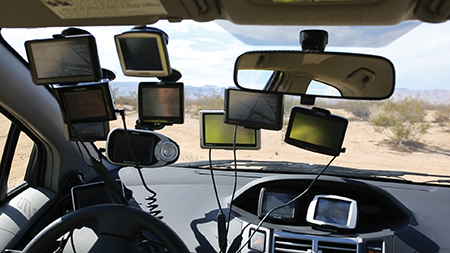
In his video California Bloodlines (GPS Dozen) (all works 2013), California artist Jesse Sugarmann drives through a bright desert expanse in search of somewhere elusive. The camera is trained on the car’s dashboard and windshield, which are festooned with 12 GPS devices that relegate the dramatic landscape of sand and scrub, distant mountains and azure sky to a removed presence. As he drives, a chorus of robotic voices talk over one another, blurting out contradictory directions (‘Turn left!’, ‘Turn right!’, ‘Re-calculating!’). Sugarmann’s intended destination is California City, from which the artist’s exhibition at Fourteen30 Contemporary took its name: a place real enough to have assigned geo-positioning coordinates, yet not real enough for the dozen devices to reach consensus.
Geographically, California City is the third-largest city in the Golden State. Its 40- square-mile grid in the Mojave Desert was developed in the 1960s in tandem with the California Aqueduct, which would transform the arid terrain into a lush, cosmopolitan oasis, a two-hour drive north of Los Angeles. But when the aqueduct was rerouted to the west, development was abandoned. In the ensuing half-century, a population of 15,000 made California City home, leaving the unfinished infrastructure of sidewalks and roads to be slowly reclaimed by the desert. Today, the outskirts of this unrealized city play host to Air Force weapons testing and off-road motor sports.
Symbolically, the site evidences a kind of regional amnesia, in which the glitz and glamour of Southern California’s main cultural centre allows this also-ran destination to fade from collective memory. But Sugarmann leverages its metaphoric impact for more personal ends, using California City as a stage to contemplate his mother’s worsening Alzheimer’s. This place, which bears the fundamental shape of a city but conspicuously lacks the city itself, becomes an analogue for his mother’s frustrated attempts to recall and organize a past she knows exists, but can’t seem to access.
In a second video, California Bloodlines (Parts 1 and 2), the artist has arrived in California City, or at least one of its desolate cul-de-sacs. Joined by an assistant, Sugarmann performs a series of actions addressing the site’s past, present and the irreconcilable divide between them. Initially, they appear as stewards, attempting to restore the road to working condition. They patch a makeshift bonfire pit left by an off-road after-party, sweep sand off the weather-beaten pavement (as desert winds violently undo their efforts), and spread a new layer of asphalt. But with the appearance of a sand dragster, a vehicle equally at home on sand or tarmac, the site’s present-day activities creep in, creating a confused connection to its past: the duo spreads asphalt on the exterior of the dragster and sets it ablaze.
In California Bloodlines (Parts 1 and 2), Sugarmann interpolates scenes of his own ‘weapons testing’ in California City, drawing square-mile development tracts onto Perspex in liquid napalm and burning them into the surface. These works were displayed in the gallery like production stills or outtakes from the film, each image executed in thick black burn marks and feathery yellow flickers. It’s not hard to connect the geometric patterns of the tract with the mapping of the human brain in neuro-imaging techniques.
Sugarmann’s previous body of work focused almost exclusively on cars – as figurative bodies, ‘vehicles’ for projecting human desire and as ubiquitous monuments to the fact of obsolescence and mortality. With the California City videos, this connection between subjects and their automotive stand-ins is made more powerful by the artist’s equation of the landscape with memory. Here, the internal stage of mental function – or in the case of his mother, dysfunction – is depicted in physical, spatial terms. And, tragically, in the enacted folly of restoring unused roads, he illustrates how that which is forgotten can never be recovered.
John Motley
Related Links:
Tuesday, February 04. 2014
Love in the Time of Algorithms | #book #algorithms
Via #algopop
-----
By Plummer Fernandez
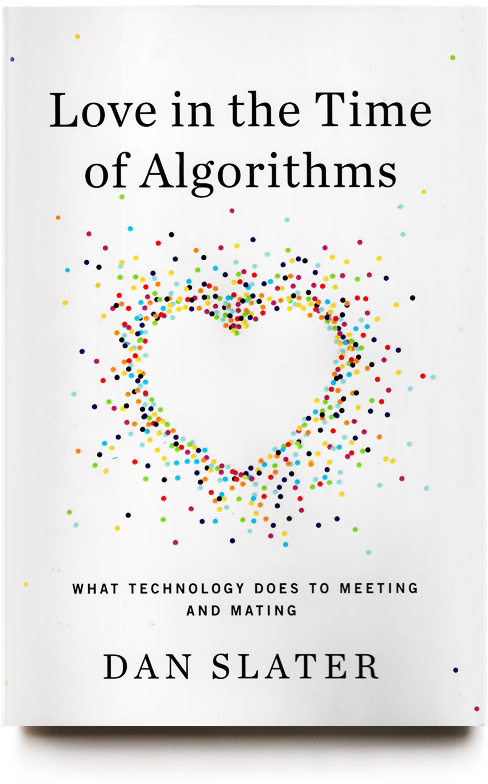
Love in the time of algorithms by Dan Slater. A book about the online dating industry. I think the title of this book alone makes this relevant to #algopop.
Also researchers at the University of Iowa are developing an algorithm that much like Netflix, will recommend partners for dating based on data-mining rather than user input. The concept is based on the assumptions that a user’s self-curated profile is not entirely truthful, and that he or she 'may not know themselves well enough to know their own tastes in the opposite sex', so algorithms could potentially get to know the real you, and your potential partner, through your dating-site browsing habits.
Related Links:
Friday, May 11. 2012
‘Feel Me’ by Marco Triverio – Digital touch and new channels for bit-intimacy
-----

Feel Me is a project by Marco Triverio that explores the gap between synchronous and asynchronous communication using our mobile device in attempt to “connect differently” and enrich digital communications. Whereas we draw lines between phone conversations and sms messages, Feel Me looks for space in between that would allow you to be intimate in realtime, non-verbally using touch.
Based on the finding for which communications with a special person are not about content going back and forth but rather about perceiving the presence of the other person on the other side, Feel Me opens a real-time interactive channel.

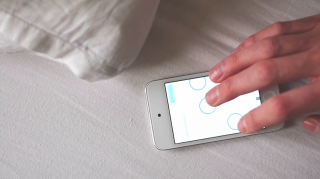
Feel Me first appears to be a text messaging application. When two people are both looking at the conversation they are having, touches on the screen of one side are shown on the other side as small dots. Touching the same spot triggers a small reaction, such as a vibration or a sound, acknowledging that both parts are there at the same time. Feel Me creates a playful link with the person on the other side, opening a channel for a non-verbal and interactive connection.
“Feel Me” was awarded honors at CIID. Marco is currently working as an interaction designer at IDEO.
See also concept development videos below.
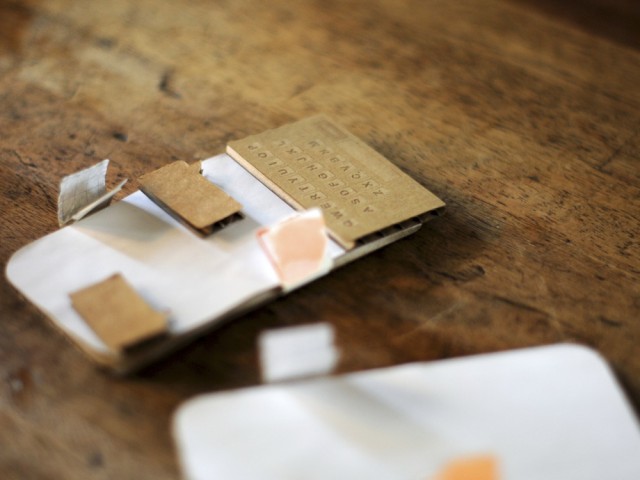
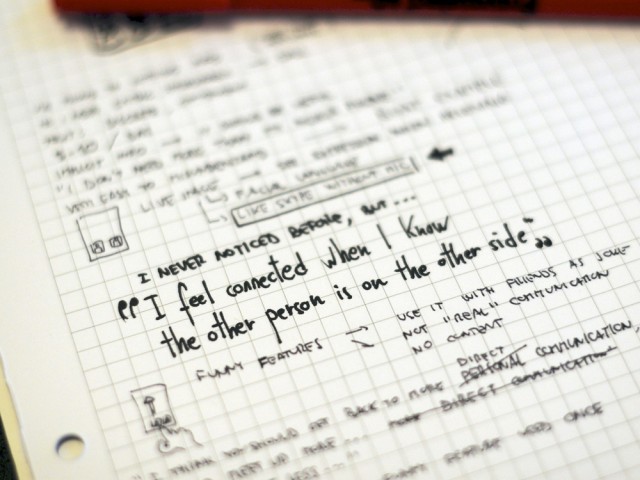
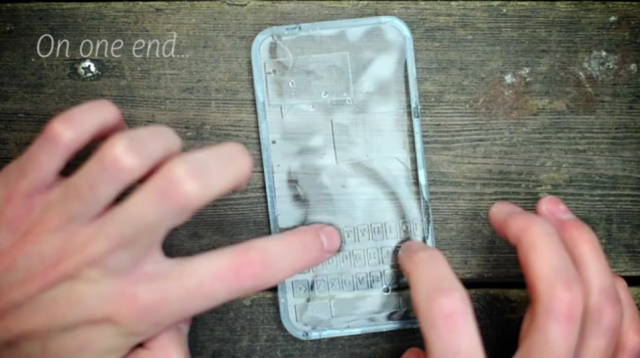

Thursday, April 12. 2012
(Paranoid Shelter) - Globale Surveillance
By fabric | ch
-----
Last week I published a post about Paranoid Shelter, a recent architectural installation by fabric | ch that deals with "smartness", sensing and surveillance. As explained then, this new work can be displayed on its own, as a study on the "contemporary shelter" that articulates the notions of (the nearly fantasized) shelter and the one of surveillance. But this installation or "architectural device" was also created with a collaborative context in mind.
This collaboration, or at lest the first one, was for a theatrical: Globale Surveillance, for which we worked on the scenography and co-initiated the project. This is a project and performance-like theatrical staged by Eric Sadin, a french essayist and writer, based on the books Globale Paranoïa (Éditions Les Petits Matins, 2009) --fiction-- & Surveillance Globale (Climats/Flammarion, 2009) --theory--, both written by him. NOhista (sound and video design) as well as Abigail Fowler (light design) joined the team to finalize the project as well, of course, as the two comedians, Laure Wolf and Gurshad Shaeman.
Rehearsals and opening of Globale Surveillance were last February and March in Caen (France), at the Comédie de Caen-Centre Dramatique National de Normandie (CDN). The play should travel to Paris for the new theater season (12-13) and then hopefully to other cities in France and Switzerland, before, eventually to travel further away and in english.
GLOBALE SURVEILLANCE
About the play (notice from the Comédie de Caen):
We live in a world under surveillance, no one would dispute that point anymore. But what configurations do the new devices of control take, in what forms and in which way are they different from the practices of the last century? How do they alter our relationship to the world and to the others? Do they reach the point of threatening the right to privacy? Globale Surveillance sets up an hyper-monitored zone, within which actors and spectators are subject to quantities of traceability procedures, in this case made visible, conversely many scary mechanisms at work daily that are affected by the phenomenon of invisibility.
Text & staging : Éric Sadin
Scenic architecture, responsive spatial device : fabric | ch
Sound & video design : Nohista
Light design : Abigail Fowler
Comedians : Laure Wolf & Gurshad Shaheman
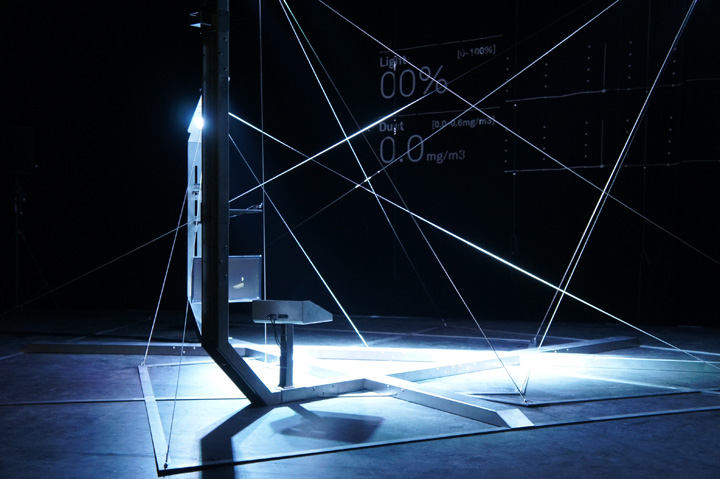

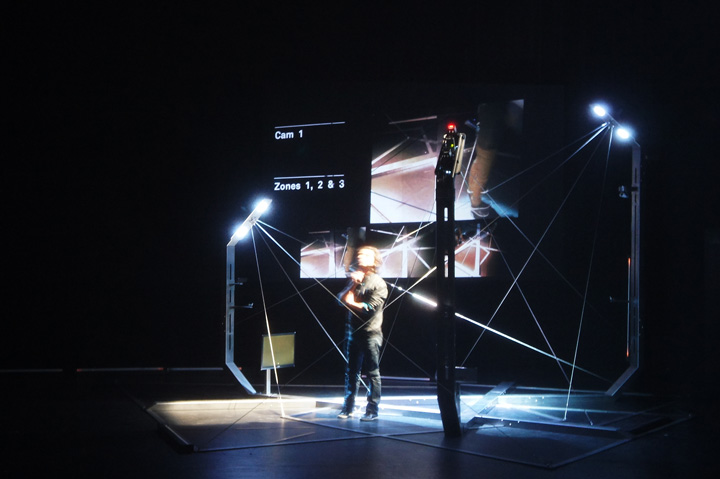
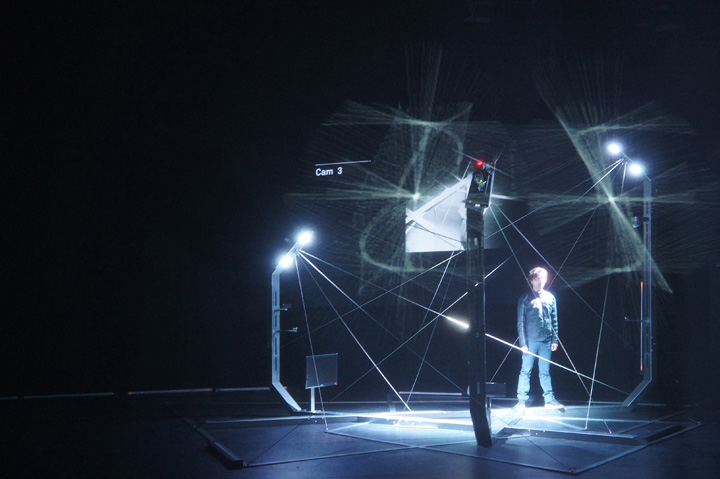
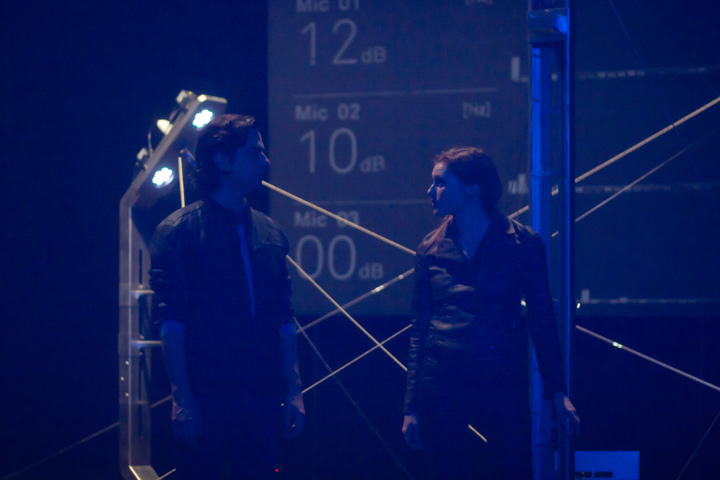

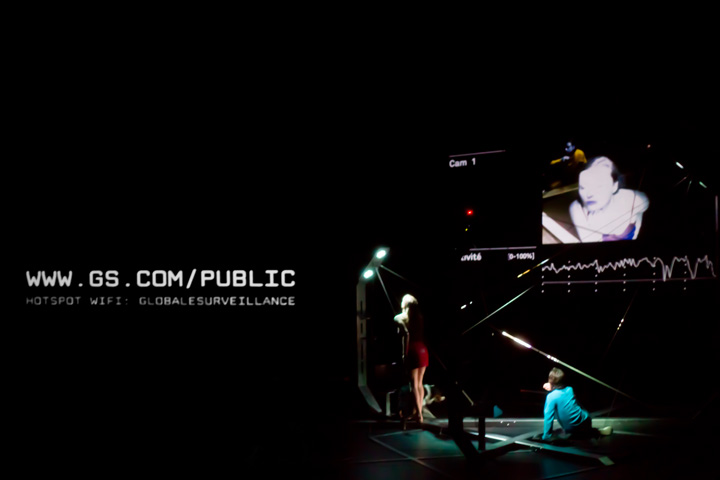
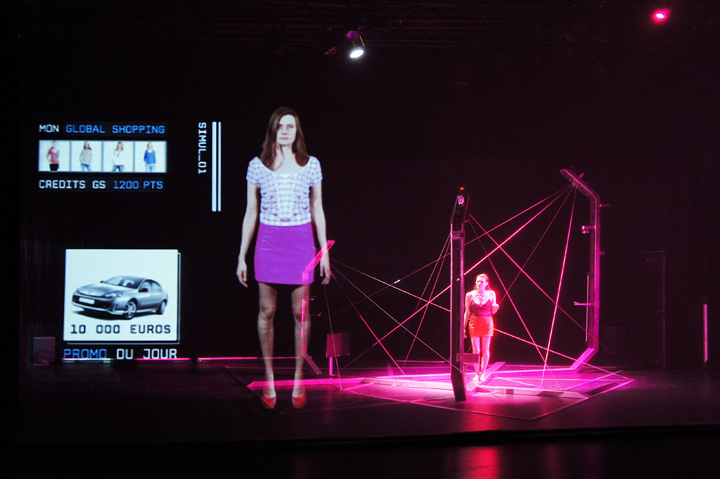

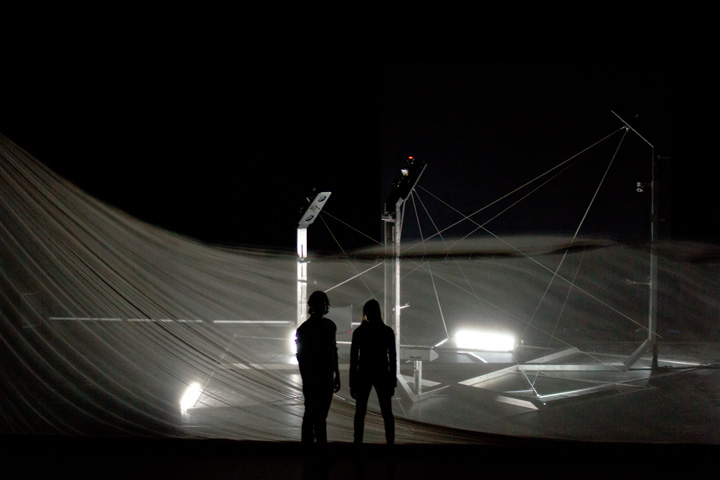
Paranoid Shelter on stage during the play with the two comedians (Laure Wolf, Gurshad Shaeman), CDN (Centre Dramatique National) / ESAM of Caen in France.
GLOBALE SURVEILLANCE from Bruno Ribeiro on Vimeo.
A compressed preview and short of the play by NOhista.
-
.jpg)
Pictures: Nicolas Besson, Patrick Keller, Alban Van Wassenhove
-
Co-production: Comédie de Caen-Centre Dramatique National de Normandie (CDN), France; Ecole supérieure d'arts et médias de Caen (ESAM), France.
With the support of: DICRéAM, France; Office Fédérale de la Culture, Swirtzerland; Pro Helvetia, Switzerland; Ville de Lausanne, Switzerland and Etat de Vaud (Switzerland).
Related Links:
Friday, November 11. 2011
Live Stage: Tracing Mobility [Berlin]
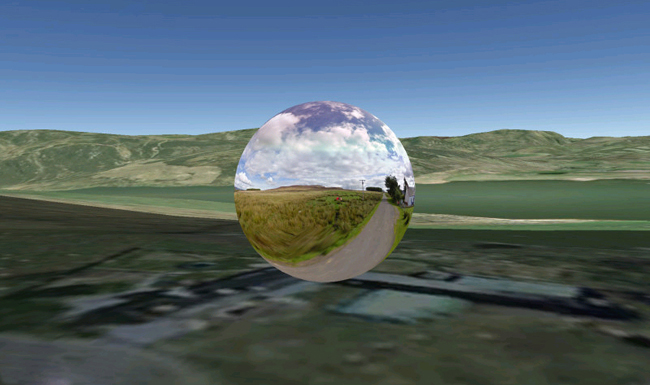
Tracing Mobility: Cartography and Migration in Networked Space — Exhibition, Symposium and Open Platform :: November 24 - December 12, 2011; Opening: November 23; 7:00 pm :: Haus der Kulturen der Welt, John-Foster-Dulles-Allee 10, 10557 Berlin.
Tracing Mobility sets out to examine the shifting terrain of global versus individual mobility and how its hand in hand development with networked infrastructure is transforming our conceptions of time, space and distance.
Where can we escape to when online- and offline worlds converge? What does the movement of a body in a landscape indicate when every point of the earth is within reach through the aid of digital technology? How do mobile devices and media alter our mindset and change our perception of time and space?
With installations, videos, performances and paintings, but also iPhone Apps, maps and open-source collaborations, we see artists developing strategies in order to position themselves within this dynamic topography.
A Symposium and the Tracing Mobility Open Platform offer further explorations of these themes via lectures, talks and workshops.
Exhibiting artists: Frank Abbott (UK), Aram Bartholl (DE), Neal Beggs (UK/FR), Heath Bunting (UK), Janet Cardiff / George Bures Miller (CAN), Miles Chalcraft (UK/DE), Simon Faithfull (UK/DE), Yolande Harris (UK/NL), Folke Köbberling & Martin Kaltwasser (DE), Landon Mackenzie (CAN), Open_Sailing, plan b (Sophia New & Dan Belasco Rogers) (UK/DE), Esther Polak & Ivar yan Bekkum (NL), Gordan Savicic (AT/NL), Mark Selby (UK), Michelle Teran (CAN/DE)
Programme:
November 23
7pm Opening
9pm Artist Talk with Simon Faithfull, Landon Mackenzie, Esther Polak & Ivar van Bekkum
November 26
11 – 5pm Symposium, Entrance: 20 €/15 €
2pm Participatory Performance „Performing StreetView“ by Esther Polak & Ivar yan Bekkum (NL)
(registration required)
December 12
7pm Finissage | Artist Talk with Aram Bartholl, Folke Köbberling & Martin Kaltwasser, plan b
(Sophia New & Daniel Belasco Rogers)
High-res pictures are available on request: presse [at] trampoline-berlin.com
Tracing Mobility is a project by Trampoline - Agency for Art & Media, in cooperation with Haus der Kulturen der Welt and Radiator Festival Nottingham, curated by Miles Chalcraft and Anette Schäfer.
Wednesday, July 06. 2011
This Is the Connected States of America
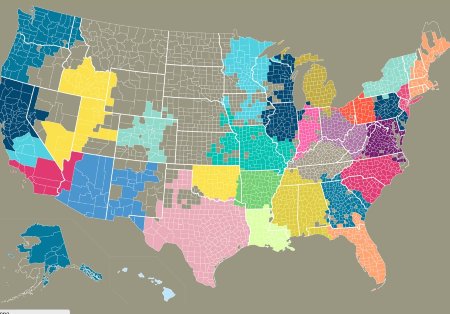
This is what our state lines might look like if we drew them based on who actually talks with each other, at least according to cell phone data gathered by MIT. These are the geographic clusters of who texts with whom within an area, from the MIT Senseable City Lab's Connected States of America mapping project.
If volume of communication determined state lines, New York City would break ranks with the state that shares its name and join up with oft-maligned New Jersey. Mississippi and Alabama would merge, so would most of New England. Wisconsin would split in two to join Illinois and Minnesota.
But one can also look at how a given regions talk with other regions, and how close those ties are, distance factored in. The map below is of Los Angeles' connections to the rest of the country. Red areas are those with the most connections to L.A. according to cell phone conversations.
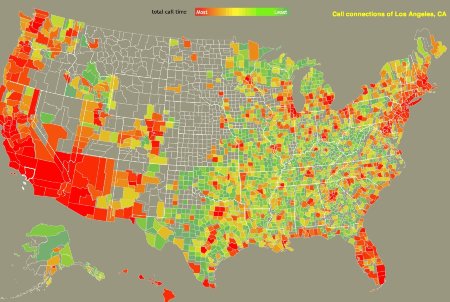
The Connected States of America project's interactive maps and visualizations show us how different parts of the country interact, and raise the question, what is a community? There was a simple answer 60 years ago when geography determined who you talked with, bonded with, and spent your life with. Now that families are scattered across the country for college, jobs, or wanderlust, and companies set up bi-coastal offices without a second thought, that's no longer true. Should we care that the people we're most connected with aren't necessarily nearby?
Play around with the maps at MIT's site. For a little inspiration, watch this short video.
Related Links:
Tuesday, March 01. 2011
Electronic Topographies | Peter Jellitsch
Via dpr-barcelona
-----

“Observing the radiowave behaviour becomes a means to understand the present and anticipating the future of urban environments. In my observation the dimension unit for public space is not meter, kilometer or decibel anymore, it’s milliwatt, hertz and gigabyte.” This is Peter Jellitsch statement on his project Electronic Topographies.
This statement inevitably makes us go back in time to 1971 and think on Ugo La Pietra‘s project Sistema disequilibrante: Casa Telematica [The Domicile Cell: A Microstructure: within the Information and Communications Systems], where he aimed to create a living environment which postulates the development of information and communications systems with respect to their technical, mechanical and electronic characteristics; using them in a way that will overcome the “barrier” that they create between us and reality. Felicity Scott pointed on her article for Grey Room Architecture or Techno-Utopia:
La Pietra’s “Domicile Cell”, for instance, operated precisely through situating itself within this system. As La Pietra [optimistically] explained the strategic intimacy of his domicile unit, “it becomes a center for gathering, processing and communicating information; a microstructure that can intervene in the information system by enlarging and multiplying exchanges among people, with everyone participating in the dynamics of communication.”
The “unbalancing systems” proposed by La Pietra were based on a serie of physical and mediatic interventions within the urban landscape. In that sense, we can consider his project as a predecessor of the Electronic Topographies.
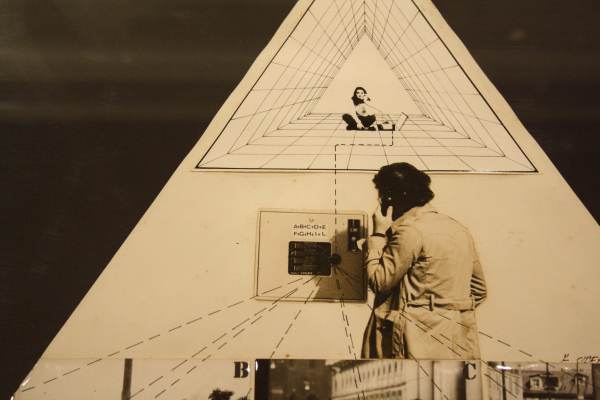
Casa Telematica by Ugo La Pietra. Pic by dpr-barcelona
After this look into the past, we can clearly talk about the interest of architects in new communication technologies and what now is called the Sentient City. Jellitsch points that cities are slightly transforming due to several phenomenas. Radio wave and the resulting ubiquitous communication possibilities is one of the very contemporary factors with which a city has to deal with. Since the beginning of the 90s a high effort was taken on the distribution of mobile communication aerials. His research is based in Austria, and he points that now, 20 years later, Austria is one of the densest covered regions in the world with 20% more mobile phone subscribers than inhabitants. Jellitsch argues that the city center of Vienna was used as testing laboratory wich stands exemplarily for the extremly dense Austrian network coverage.
The electronic topographie drawing series is trying to simulate the actual situation on electromagnetic cones which are coating the physical space. Focusing on transmitter heads for mobile communication, the drawing series allows to have a alternate view on public areas which are now qualified through it’s connecting possibilities. And he adds:
In June 1881 the commercial ministry of the K&K monarchy gave the Viennese private telegraph society a concession for the cablephone arrangement in a radius of 7,5km around the “Stephansturm”. Literally said, the communication spreading in austria has started in a small area around the Stephansdom nearly 130 years ago. Since 1993 the 1st viennese district has a 100% mobile network coverage that startet with basic technologies like GSM, followed by UMTS and now has 100% connection in 3G technologie. Due to several reasons, the inner city of Vienna has the highest connecting qualities compared to the other districts, as well as the densest transmitter pattern.
The current sentient city is subdivided, carved, segregated and coated by electromagnetic oscillation.

Complete map of Vienna’s communication network
Based on the previous data, Jellitsch worked on a “rastogram“, which basically describes how we inhabit and coexists with urban spaces where our body gets coated from electronic waves.
We can also mention here Fabien Girardin‘s research for his PhD thesis on human interactions with ubiquitous geographic information. Girardin focus his research on the increasing use of mobile devices, wireless infrastructures, and the Internet that, according to him, is changing our daily lives, not only in the way we communicate with each other or share information but also how we relate to the environment. And he adds:
Through our interactions with these technologies we access and generate an informational membrane, hovering over the spaces we live in and visit. However, this information layer only imperfectly models the reality due to coarse digitization and technological limitations, challenging the human interaction. On the other hand, the presence of this user-generated ubiquitous geographic information opens novel perspectives in understanding human activities over space and time.
The common link between Girardin and Jellitsch projects are the aspects of human interactions with ubiquitous geographic information.
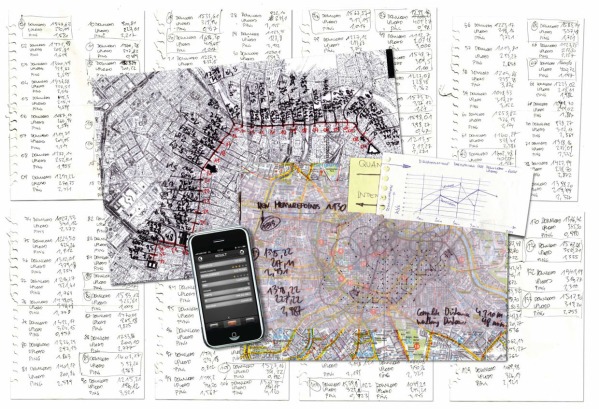
Measuring connections. Peter Jellitsch

Connectivity Figure. Peter Jellitsch
The operator topographies drawn by Jellitsch shows the valency of public areas related to the amount of mobile communication users. The mobile operator firms have to install the right amount of transmitter heads, to ensure a maximum of quality. Through reading, drawing, simulating and translating the construction plans, one is able to reflect the quality of transmitter heads back to intensive public areas.
The electronic topographies’ drawing series is trying to simulate the actual situation on electromagnetic cones which are coating the physical space. Focusing on transmitter heads for mobile communication, the drawing series allows to have a alternate view on public areas which are now qualified through it’s connecting possibilities, that are reflected on the complete set of the Electronic Topographie maps.
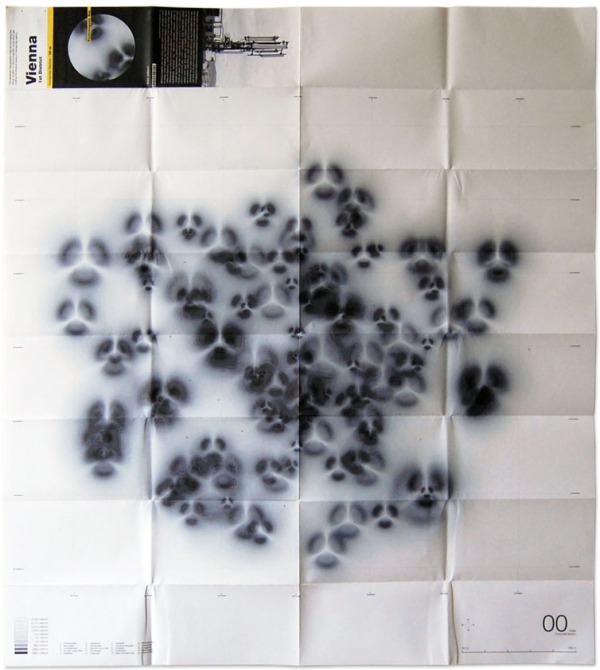
Electronic Topographie map. Peter Jellitsch

Electronic Topographie map. Detail. Peter Jellitsch
As a final point of his research, Peter Jellitsch worked on two specific issues of the project:
[1] The roentgenograms. These are two models made with acetate sheet, plexiglas, lightconstruction, aluminium sticks and a tripod. Roentgenograms shows an alternative top-view on two public spaces in the 1st Viennese district. Cutted through an invisible electromagnetic cone, the viewer is looking through a 54m thick electronic data-cloud that is coating the city of Vienna.
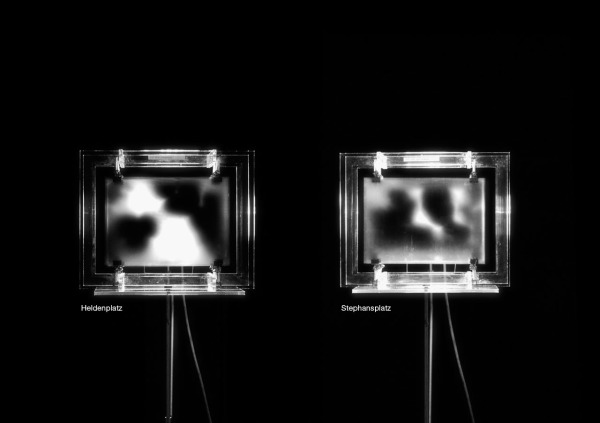
Roentgenogram. Model 1. Peter Jellitsch
[2] Coated Environment [animation, 1:20min]. The general technical progress has led to an estrangement and perceptual change of a person in the relation to his/her environment. The coated environment animation could be seen as recording and notional grading of our surrounding through crossing hidden audiovisual signals. The intent of the animation is the concentrated and conscious perception of an existing physical realm, and attempts to extend the pure seeing into an alternate cognition.

Coated Environment. Filmstill 02. Peter Jellitsch
The “hybridization” of space is only an expression of wider radical changes between analytical systems [order and spacing] to synthetic [complexity, connectivity, permeability] ones. In a system characterized by its high capacity for communication, if space becomes a mix between reality and virtual presence, the separation between private and public space becomes obsolete. According to this theory of urban permeability, the concept of “filter” is important as a new indispensable device. Filter as a mean of connection with the capacity of handling private/public, real/virtual, inside a system where the channels are not separated anymore. Now these channels are communicating -APERTURE-.
From the paper Aperture, Urban Hybridization
Now we’re facing a renewal of the urban experience. With the growing complexity of cities and the fragmentation of urban space, the experience of the city ceases to be static-reflected by city maps and grows as dynamic flows. And the importance of the Electronic Topographies project lies in the way it shows how public spaces become the sum of the built environment and our virtual interactions.
Are we already leaving inside Ugo La Pietra’s “Domicile Cell”?
—–
Thanks to Peter Jellitsch for sharing his project with us!
Recommended readings:
- The video Coated Environment by Peter Jellitsch can be visited at vimeo
- Fabian Girardin PhD Thesis Aspects of implicit and explicit human interactions with ubiquitous geographic information
- El espacio público como catalizador de colectividades locales by Domenico di Siena [SPANISH]
- To this date, Ecosistema Urbano is working on Smart Streets: a research proposing “a public space equivalent to the innovative self-organizing and exchange processes occurring on the web”
Personal comment:
To my knowledge, Dunne & Raby are among the first who brought (back --as communication was a quite proheminent theme in the architecture of the late 60ies and early 70ies--) this theme of electromagnetism into design and architecture during the late 90ies and early 00oes and study the effect of these invisible landscapes. A lot of work has been done since around this theme then.
More recently, the research of Timo Arnall about elastic space can be mentioned (he just recently published this video about wifi territories, that has been rebloged a lot since).
"fabric | ch", Art Contemporain et Nouveaux Médias (éd. D. Moulon), Scala (Paris, 2011)
fabric | rblg
This blog is the survey website of fabric | ch - studio for architecture, interaction and research.
We curate and reblog articles, researches, writings, exhibitions and projects that we notice and find interesting during our everyday practice and readings.
Most articles concern the intertwined fields of architecture, territory, art, interaction design, thinking and science. From time to time, we also publish documentation about our own work and research, immersed among these related resources and inspirations.
This website is used by fabric | ch as archive, references and resources. It is shared with all those interested in the same topics as we are, in the hope that they will also find valuable references and content in it.
Quicksearch
Categories
Calendar
|
|
July '25 | |||||
| Mon | Tue | Wed | Thu | Fri | Sat | Sun |
| 1 | 2 | 3 | 4 | 5 | 6 | |
| 7 | 8 | 9 | 10 | 11 | 12 | 13 |
| 14 | 15 | 16 | 17 | 18 | 19 | 20 |
| 21 | 22 | 23 | 24 | 25 | 26 | 27 |
| 28 | 29 | 30 | 31 | |||

